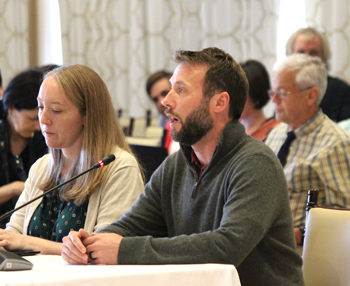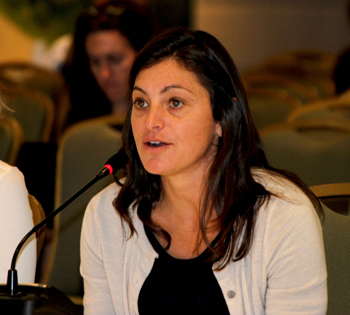Groundfish Sector System
“This patient’s about to die”
by Laurie Schreiber

Ben Martens, executive director of the Maine Coast Fishermen’s Association (MCFA). “After eight years this experiment thus far has been a failure. After this review process, the council should set up a comprehensive response to the concerns and issues raised and address the shortcomings of this system for fishing businesses, fishing communities, and the marine resource. The New England groundfish fishery is on the cusp of seismic change.”
GLOUCESTER, Mass.—New England’s catch share/sector management system in the groundfish fishery is failing – shrinking the fleet, putting small boats out of operation, and preventing next-gen fishermen from getting.
That’s what fishermen told the New England Fishery Management Council (NEMFC) at its September meeting.
“When we started catch shares, stocks were in pretty darn good shape. Nobody was complaining,” said fisherman Carl Bouchard. “Now…everything’s a disaster. Half the fishermen have gone out of business. There’s no inshore fishery left.”
Bouchard added, “I’m not sure where the disaster is, if it’s the stock assessment or in the management system of catch shares.”
Fisherman Ed Barron called the system “a complete failure,” adding, “We don’t’ have the luxury of time to fix it. The fishing industry is going down the tubes really quickly.”
“When we first started sectors, everything was good,” said Joe Orlando, a Gloucester, Mass., fisherman and president of Sector 2. “We were making money. We had a lot of boats.” But since 2010, Sector 2 has lost two-third of its boats, he said.
“Sectors are on life
support. This patient’s
about to die.”
– David Goethel,
fisherman and
NEFMC Advisor
“Sectors are on life support,” said fisherman David Goethel. “This patient’s about to die.”
“We don’t have an economically productive fishery right now,” said Jackie Odell, executive director of the Northeast Seafood Coalition in Gloucester. “We don’t have many participants.”
Consolidation of the fleet has been significant, and operational costs have grow significantly, she said. Some sectors have stopped operations because they don’t have enough fish quota to cover expenses, she said.
“We’re in a bad place,” Odell continued. “A lot of us have spent a lot of time expressing our concerns about the science and will continue to do so.”
NEFMC received written comments as well. Among them, Portland fisherman Brian Pearce said, “The most catastrophic problem of catch share fishery management in New
England is that the stock assessments and actual fish stocks are disconnected. Fishermen are trying to find areas to avoid choke stocks, rather than find fish!”
He citied the following problems:
• Prices to lease choke stock fish go up, because of low inventory;
• Prices paid to boats are low, because wholesale buyers can’t get enough fish to make it a marketable product;
• Fishermen lose money, which results in the risk that the entire fishery will shut down.
Ben Martens, executive director of the Maine Coast Fishermen’s Association (MCFA), wrote that MCFA was an early supporter of the sector system. MCFA manages the Maine Coast Community Sector, which has 60 members in Maine, New Hampshire, and Massachusetts. The hope, he wrote, “was that by moving to a catch share program, fishermen would get some business flexibility while putting important fishing mortality constraints in place. This would create better science, better management, a healthy fishery and more profitable businesses.”
But after eight years, he continued, “this experiment thus far has been a failure.” Many members still support the concept, but successful catch share management relies on accurate data and accountability on the water, which have been lacking. But NEFMC still has an opportunity to fix the program, he said.
“After this review process, the council should set up a comprehensive response to the concerns and issues raised and address the shortcomings of this system for fishing businesses, fishing communities, and the marine resources,” he wrote. “The New England groundfish fishery is on the cusp of seismic change. Some for good, some for bad, but all will have resounding and far-reaching impacts.”
“We’re in a bad place.
A lot of us have spent a
lot of time expressing our
concerns about the science
and will continue to do so.”
– Jackie O’Dell
The comments came during a presentation by the Gulf of Maine Research Institute (GMRI) on its review of the New England groundfish sector management system. The review, commissioned by NEFMC, started with a series of nine meetings held this past summer from Ellsworth to East Hampton, N.Y. The review was designed to focus on fishing years 2010 to 2015. But meeting and written comments weren’t confined to those years.
“The meetings got quite emotional at times,” GMRI Chief Community Officer Jonathan Labaree told NEFMC.
Labaree said three overriding themes emerged from the comments:
• Sectors versus days-at-sea and how the transition played out
• Stock assessments
• Infrastructure and markets
The general feeling, he said, was that, in the current situation, the days-at-sea system would likely be more unworkable than the sector system.
“That said, there were some ports that had a strong preference for the days-at-sea system,” he continued. “Some of those ports were ones that didn’t fare well in the transition from days-at-sea permitting to quota allocations under the sector system.
Part of that had to do with investments fishermen had made in their days-at-sea permits, he said.

We don’t have an economically productive fishery right now. Consolidation of the fleet has been significant, and operational costs have grown significantly, she said. Some sectors have stopped operations because they don’t have enough fish quota to cover expenses. Jackie Odell, executive director of the Northeast Seafood Coalition in Gloucester. Fishermen’s Voice file photo.
“A lot of people had invested in days-at-sea permits and found them to be worthless afterward,” he said. They were also impacted by relative allocations of fish to their ports, due to factors like trip limits on certain species and closures.
“So there was a sense that different ports made out differently in the transition,” he said.
“Every single port and almost every person talked about stock assessments,” he continued. “There’s a strong sense that the stock assessments are not accurate.”
And yet the success of the sector system relies on accurate and timely assessments, both in the absolute number of fish and the relative number of fish, he said.
“When assessments are out of whack…it creates choke species and makes it extremely difficult for fishermen to avoid fish they find plentiful, and it prevents them from catching the rest of their allocation,” he said.
The bigger issue, he said, is that the nature of the assessment is creating a level of uncertainty that both skews lease prices and, ultimately, market prices for fish.
“That impacts all levels of the industry,” he said.
The reviewers also heard, pretty consistently throughout the region, that there’s “a real downward spiral in loss of infrastructure and markets,” he said.
That makes it increasingly difficult for smaller ports to operate and even has impacts on larger ports, and on markets due to inconsistent landings, which has resulted in loss of buyers.
“People aren’t showing up at auctions,” he said. That, in turn, has impacted pricing.
Consistent prices depend on having a consistent supply.
“It’s hard for smaller ports and vessels to do that,” he said. But, he added, the problem is not universal across the region.
There was a general sense throughout many of the meetings that NEFMC and federal managers “don’t fully understand how sectors work internally and don’t appreciate the self-regulatory nature of the sector system,” he said.
Also, he said, remnant effort controls from the days-at-sea system can make it difficult to operate in the sector system. For example, limits on vessel size and horsepower are preventing some vessel upgrades, making it difficult to get offshore and take advantage of other fishing opportunities.
“If we took a more comprehensive look at removing remnant effort controls, it would create more opportunity and maybe more flexibility in the fleet,” he said.
There was quite a bit of talk at the meetings about leasing practices, he said. Some people recognized that fishermen who were leasing out their quota to others, in order to make the most of their investment until it was worthwhile to get back into the fishery, was a useful strategy.
But others said the practice unfairly tied up allocation and made it more difficult for others to participate.
“There wasn’t universal agreement,” he said.
He added, “One thing we heard was, ‘We don’t need a ton more fish necessarily. We just need enough that represents what’s out there.”
It’s expected that GMRI’s final report will be submitted this December. The report will contribute to NEFMC’s work to develop future management actions.
